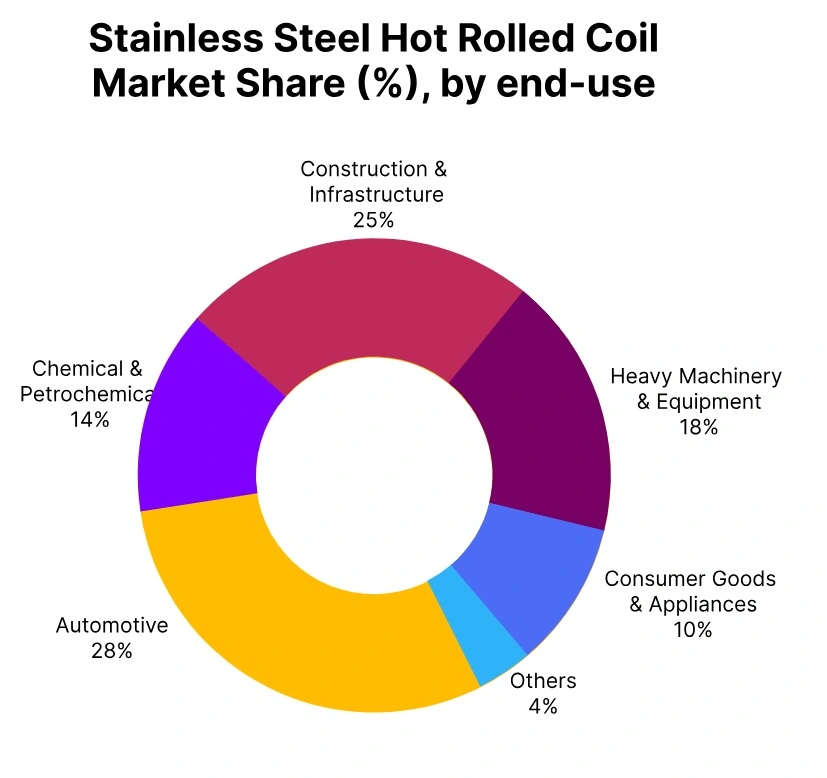Price-Watch’s most active coverage of Stainless Steel HR Coil price assessment:
- 304-3mm FOB Shanghai, China
- 304-3mm FD-Willich, Germany
- 304-3mm Del Alabama, USA
- 304-3mm Ex-Mumbai, India
- 312/2B-5mm FOB Shanghai, China
- 312/2B-5mm CIF Klang (China), Malaysia
- 312/2B-5mm CIF Hai Phong (China), Vietnam
- 312/2B-5mm CIF Laem Chabang (China), Thailand
- 312/2B-5mm CIF Nhava Sheva (China), India
- 304-3mm CIF Klang (China), Malaysia
- 304-3mm CIF Hai Phong (China), Vietnam
- 304-3mm CIF Laem Chabang (China), Thailand
Stainless Steel Hot Rolled (HR) Coil Price Trend Q3 2025
In Q3 2025, the global Stainless Steel Hot Rolled (HR) Coil market showed a mixed performance, with select regions witnessing mild strength while others remained constrained by weak demand and competitive supply conditions. Steady industrial activity in some markets provided modest support, but overcapacity and subdued buying interest limited Stainless Steel Hot Rolled (HR) Coil price trend momentum overall. Stable raw material trends and controlled production kept volatility low, while restocking during September provided limited relief. Overall, the global market maintained a cautiously stable tone heading into the final quarter of the year.
Germany
Stainless Steel Hot Rolled (HR) Coil Domestic prices FD- Willich, Germany, Grade- 304-3mm.
The Stainless Steel Hot Rolled (HR) Coil price trend in Germany dropped by 1.5% in Q3 2025, as weaker offtake from construction and automotive segments combined with competitive imports from European mills pressured local pricing. Domestic producers operated at steady utilization rates, but market activity remained subdued due to high input costs and limited export opportunities.
End-user consumption did not show significant improvement throughout the quarter, dampening sentiment. However, Stainless Steel Hot Rolled (HR) Coil price trend in Germany increased slightly by 0.13% in September 2025, supported by short-term replenishment orders from distributors and modest restocking from industrial processors, although overall demand remained restrained.
USA
Stainless Steel Hot Rolled (HR) Coil Domestic prices EX Alabama, USA, Grade- 304-3mm.
The Stainless Steel Hot Rolled (HR) Coil price trend in the USA rose by 1.10% in Q3 2025, supported by steady demand from energy, construction, and manufacturing sectors. Tight domestic supply conditions, owing to scheduled maintenance at select mills, contributed to upward pressure on prices. Market sentiment was stable throughout the quarter, with end-users maintaining moderate procurement levels to meet ongoing project requirements.
However, Stainless Steel Hot Rolled (HR) Coil price trend in the USA edged up marginally by 0.03% in September 2025, reflecting balanced market dynamics as supply and demand remained well-aligned, though buyers remained cautious amid uncertain third-quarter economic data.
China
Stainless Steel Hot Rolled (HR) Coil Export prices FOB Shanghai, China, Grade- 304-3mm.
According to Price-Watch, In Q3 2025, the Stainless Steel Hot Rolled (HR) Coil price trend in China decreased by 1.09% as industrial production has been lower than expected while overall demand from the downstream fabrication and machinery sectors has been weakening. Domestic excess capacity continued to suppress prices in China, with steady supply levels amid very slow consumption. The level of export orders also fell, as other Asian suppliers began to gain business.
Although input costs remained stable and provided little support for the market, the tone of the market was quite muted. Stainless Steel Hot Rolled (HR) Coil prices in China fell 0.4% in September 2025, after seasonal demand fell back while buyers have been cautious about restocking and not willing to place larger orders amid uncertainty about demand in the short-term.
India
Stainless Steel Hot Rolled (HR) Coil Domestic prices EX-Mumbai, India, Grade- 304-3mm.
According to Price-Watch, the Stainless Steel Hot Rolled (HR) Coil price trend in India fell by 1% during Q3 2025, influenced by reduced consumption from engineering and infrastructure sectors. Ample domestic supply contributed to the price declines, particularly since imports from Asian steelmakers continued to be available to domestic mills. Import levels kept the pricing environment competitive, and mills had to cut offer prices to ensure they remained competitive.
While raw material prices remained stable, they have been unable to improve end-user demand. However, Stainless Steel Hot Rolled (HR) Coil price trend in India ticked up by 0.54% in September 2025, as the purchasing sentiment improved with the impending festive season demand and healthy restocking activity. Continuing demand by downstream fabricators produced some degree of stability.




